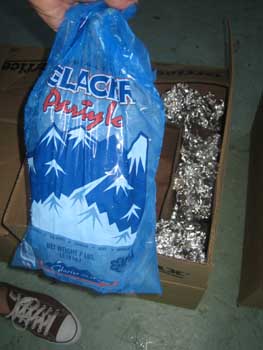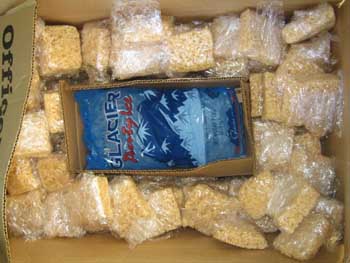


|

|
| Page 1 2 3 4 5 6 7 |

Riveted by the prospect of watching ice melt, I crouched near the boxes and waited, like a blood thirsty cougar, ready to pounce! Except instead of being thirsty for blood, I was thirsty for water! Six and a half hours later, at 7:15pm, the balloon box's water broke. I decided to take a look at how things were going inside the boxes. My thermometer still read 90 degrees Fahrenheit. |

There was a large block of ice in the aluminum foil box, but the inner cardboard was pretty soaked.
|

The Rice Crispy Treats box had a larger block of ice, but the inner cardboard was also wet. There was also water on the outside of the outer box. |

The inner styrofoam box was also wet, but the ice block was still full-sized. Cardboard had lots of ice left, Diapers had a lot, and the goose down feathers had barely melted at all. The pink balloons box also had a big chunk of ice, but it also had a problem. The lid wasn't sitting closed. With the lid propped up a bit, hot air had been able to flow in, around the balloons and get to the ice. This kind of heat loss through air movement is known as convection. I removed a few balloons, which allowed the top flaps to close properly.
|
|
|

At 11:45pm, I strolled out for another check. It was quiet. All the boxes still had plenty of ice. |

Styrofoam and Down feathers were doing very, very well, preserving large blocks of ice. The box with latex balloons had the least ice remaining. I wondered if it would last through the night. |
|
Please continue reading page 4 of testing insulation. Page four is lacking any interesting photos, so just do your best. |
Home | Contact Rob | How Much is Inside | Pranks | Incredible Stuff | Science Club
Dec 18, 2005